Analysis of Maus
Throughout Maus, by Art Spiegelman, we feel sympathetic toward Vladek. We understand that we will never be able to go through what he went through but we must try to remember the Holocaust. The main reason that the book is so powerful is that we see Vladek as a person not just as a weak prisoner that we are supposed to feel pity for. On page 134 in Volume 2 Art includes a picture of Vladek in his camp uniform. The picture's placement in the book is next to Art and Vladek talking about the picture. When Vladek tells Art about the picture, he immediately leaves to get it saying "I need that photo in my book!" (Spiegelman 134). Their conversation interrupts the flow of the story. By doing this, Art shows that the past and present are intertwined by Vladek's storytelling. The picture is tilted sideways possibly to show the disorder of the camps. Art also chose a picture of Vladek in camp uniform rather than any other picture because it shows that the stories in the book actually happened to a person. It reminds us that we cannot live through what Vladek lived through, we can only imagine. Art spends the entire book drawing his father as a mouse which lulls the reader into thinking that the book is just a story. The picture is a wake up call to remind us of the impact that the Holocaust had on Jewish lives. Maus does not serve to help us understand the traumas that Jewish people went through. Rather, it makes us remember the people affected by the Holocaust.

I really like the points you are making here Sohil. I especially like the idea that Maus may be drawn with mice and animals but the story is about real human beings which Art Speigelman makes sure to remind us of by inserting this photograph of Vladeck in his prison uniform. I also never questioned why the photograph was titled but after reading your blog I see that it represents the chaos and disorder of the Jews' lives during the Holocaust which I never considered.
ReplyDeleteNice Sohil! I liked your and I also wondered why the photo was titled sideways. I would like to that motif of the stripes again. I presents a kind of incomplete shift. Where when looking at the photo one is still reminded of the concentration camps. I agree that the photo serves as a kind of shift from the present to the interrupted past.
ReplyDeleteGreat analysis nice analysis sohil. You pointed some things I did not even notice. The analysis you made of the reader seeing Vladek as both a person and a prisoner is great.
ReplyDeleteI liked your analysis Sohil, keep up the work. I liked how you went into great detail to explain everything about the picture being chosen to why the picture has a tilt in it. I also liked how you talk about Maus in general at the end of the Blog by explaining the purpose of it.
ReplyDeleteThis accurately describes the reason Spiegelmann writes the novel the way he does. I agree that a common theme in the novel is the interconnection between the past and present. There is indeed a deliberate purpose behind the constant interruption of Vladek's recount that makes this novel more than just a biography.
ReplyDeleteI think your point that Vladek is a person who is more than just a weak prisoner is so important! oftentimes we hear holocaust stories that don't exactly delve into the unique traits and abilities of the victim and the only thing we feel is sorrow and pity. Even when Art shows how "stingy" Vladek can be, it gives him more character traits then just one of the uniform Auschwitz survivors (all of whom had unique characters that we just don't know of as well as Vladek)
ReplyDelete